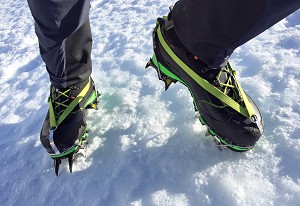
For winter running, hillwalking beginners, moderate slopes, and days when snow and ice conditions are thin and patchy, full crampons might be overkill. Here's where microspikes and their ilk come into the picture. Dan and Edith Bailey check out the range on offer from market leader Kahtoola.
Conventional crampons are standard issue for winter hill-going, and for more challenging snow conditions or steeper terrain they're indispensable. But they're not always an advantage. On easier ground, days of thin winter cover, backpacking routes with lingering snow on passes, or winter running, micro spikes offer a user-friendly, affordable and - in the right circumstances - effective alternative.
Kahtoola's range of underfoot traction devices (for want of a snappier term) covers all the bases, from minimalist runner's studs to quasi-crampons. Over this winter we've been testing the lot:
- KTS Crampons - A halfway house between microspikes and more conventional crampons
- MICROspikes - The standard design, and very effective at what they do
- EXOspikes - Tiny studs for grip on icy paths and pavements
Safety caveat
Micro spikes are understandably popular, and there seems to be a tendency for newer hillwalkers to choose them over full crampons. That's fine... until suddenly it isn't. Their limits will soon become clear if you encounter deeper snow, really hard-frozen terrain or steeper ground, when the security they can offer is simply inadequate. The danger with these things is not appreciating their limitations, and over-committing. You need to be sure your intended route on your given day will not push the limits of micro spikes; if in any doubt, opt for crampons instead.
Mountaineering Scotland recently issued advice on the difference between crampons and spikes, and the uses and limitations of both:
KTS Crampons - £125
On winter boots my standard choice of spiky thing has always been 12-point crampons, on the basis that these are a single option that allows you to go anywhere, usable for non-technical hillwalking but also capable when the ground gets steeper and more consequential, and you're actually mountaineering. However mountaineering crampons are overkill on gentler terrain, and there are days when something more forgiving would be better. You could go with conventional 10-point crampons; but there's another option that in some cases might be preferable. Enter KTS Crampons. With much shorter teeth, no front points, and a flexible linking bar that allows them to be fitted to even quite bendy footwear, they're a different proposition. And on the right day they can be just the thing.
What they're for - and what not
Following Storm Éowyn I took them for a first spin. The hills were a mix of deep wind-blown snow and scoured areas with a hard icy crust. Crampons were very much required for the top couple of hundred metres of my chosen Corbett. On the moderate-angled flanks I was visiting a full crampon would have been fine, if excess to requirements. But on the day I think I was actually better off with the KTS Crampons.
These less-aggressive alternatives from Kahtoola have ten very short teeth, and only very limited forward bite. Compared to a fully fledged crampon their stubbier teeth are less trip-over-able, less likely to catch in your opposite trouser leg, and feel less skittery on rock. In wetter snow they can ball up a little, but the shortness of the spikes does tend to prevent them from becoming giant snowballs in the manner of a standard crampon. Anti-balling inserts are available separately (I've not found I needed them as yet).
For a first crampon - say, taking children on winter hills - they'd make a forgiving and user friendly option. All considered, KTS Crampons do offer clear advantages over longer-toothed designs in the right setting. And they are still a lot more capable than microspikes, buying you more leeway - something of a halfway compromise, in other words.
They're ideal for: walking on easier-to-moderate-angled hill routes; snowy moorland; overseas hut-to-hut journeys with non-technical glacier crossings or high snowed-up passes; and glaciated approaches to summer alpine rock climbs. Winter hill runners would find them a lot more capable than microspikes. In some limited circumstances - light snow cover or verglas for instance - I can also see them doing well on a rocky mountaineering-style hill route such as Striding Edge or Crib Goch, where those short spikes might be an advantage; but let's emphasise that their use on this sort of ground should be a considered decision rather than a given.
What they are absolutely not good for is anything steep or technical, or any occasion whatsoever when front pointing will be required. In your winter arsenal, consider KTS Crampons to be a supplement to more mountain-oriented models, rather than a replacement for them.
Weight
Two sizes are available, the difference just being the length of the linking bar. At 660g for a pair of the larger version (630g small) they're a fair bit lighter than standard 10 or 12-point crampons. While I doubt you'd consider them ultralight if you're carrying them for days on a backpacking journey, they're really not bad in a day pack, and pack down pretty small. As well as being reasonably light they're robust, with tough steel teeth and a well-made feel.
Fitting
KTS Crampons can be tweaked to fit a huge range of footwear, and thanks to their flexible bar you can wear them with softer shoes and boots as well as stiffer winter-specific boots. They'll even work on running shoes. Here's the catch: when initially adjusting for size, these things are a real fiddle. Once set up, they're not too bad to put on next time, but if you're used to the simple plastic cradles of standard walking crampons then all the webbing and buckles may feel cumbersome.
MICROspikes - £65
With a stretchy rubber cradle and small - but sharp - teeth on chains underfoot, this is the standard design for microspikes, and Kahtoola's version is robust and effective. For less experienced winter walkers they're a nice user-friendly option, provided their limitations are fully appreciated.
What they're for - and what not
Gentler hill walking; dog walking on hard-packed snow; winter hill running; backpacking in places where you might have to cross the occasional moderate-angled snow patch... they're versatile, easily portable, and no effort to bring just in case. One big plus point is the fact that they'll fit any footwear, from full winter mountain boots to children's snow boots, summer walking boots to trail shoes.
MICROspikes are brilliant for very thin winter conditions such as light snow, frosty/frozen grass, and ice-covered paths - occasions, in other words, when crampons feel like overkill. They're good on patchy cover, where you're walking on dry ground one minute and ice or snow the next. Since the tiny teeth are not too trippy or skittery on bare rock in the way that crampons tend to be, you don't have to step with quite as much care, making them a more user-friendly choice for running or winter hill newbies.
However they give secure purchase only in a limited range of winter conditions, and are completely inadequate in deeper snow. The slope angle is critical, since anything remotely steep will be beyond their capability; and if you happen to be one of said newbies reading this then I make no apologies for labouring the point. I've been limiting my use to slopes on which I'm happy using poles and wouldn't ever feel the need for an axe. On a recent ascent of Cairn Gorm via Windy Ridge, for example, daughter Edith and I used them in preference to KTS Crampons, and found them spot on for the mix of stone path, gravel, soft snow, neve and sheet ice that we encountered; but I probably wouldn't want to use them on anything much steeper than this very moderate hill walk.
Weight
Coming with a carry bag, and at 380g for a pair of XL (316g size S), MICROspikes are really pretty light for the benefits they offer. Stick them in your day pack and you'll not notice the difference, so you can afford to bring them just in case even when running or backpacking. Whilst light, they do not seem remotely flimsy: The stretchy thermo-plastic cradle feels pretty tough, and the steel spikes and chains should take plenty of abuse from rocks.
Fitting
It's a very quick and easy fitting, with no adjustment or fiddling required - though stretching the cradle over your boots does take a bit of oomph and is best not done with cold-numbed fingers. The range of shoe sizes that this design fits is limited by the chain and tooth arrangement, so Kahtoola sell them in several sizes and you'll need to consult their size guide to ensure the right match for your intended footwear.
EXOspikes - £55
With tiny studs instead of teeth, EXOspikes are the minimalists of Kahtoola's range. While there's less a lot less bite in snow, the fact that they're lower profile and less skittery underfoot can at times prove an advantage.
What they're for - and what not
I'd say the primary use for EXOspikes is winter trail running, though they'd be great on slippery pavements too. Due to the obvious limitations they need to be a considered choice for days when you're expecting slippy but very lean conditions underfoot, or certain that you won't be venturing off the trodden snow on busy trails - think a couple of days after snowfall when the paths are compacted and icy.
They work brilliantly on hard ground, with enough penetration to keep you upright on sheet ice, frozen turf and neve - so long as the angle of slope is shallow. If cover is patchy and you're travelling on a mix of grass, gravel and frozen stuff, you can't be forever swapping in and out of your spikes. EXOspikes are great for this since you just keep them on throughout, something you'd never do in crampons.
A hefty caveat to all this is required. They're good on moderate-angled ground, but if you're somewhere steep enough to be considering using an ice axe then I'd say you've already far exceeded their sensible limits. EXOspikes are for low-angled, non-technical and non-consequential ground only; think forest tracks, moorland walks and wintry parks. They do have a place in the hills, but think carefully before taking them, because they're far less capable even than MICROspikes, and a whole lot less able than KTS Crampons - either of which you could also run in.
Weight
These are the lightweights of the range, my size XL weighing just 234g for the pair (196g size S). Kahtoola provide a little bag, and it really is no hassle to stick this in your pack or running vest. While the rubber cradle feels tough, I guess the plastic strips around the edges of your soles are likely to bear the brunt of rocks, so if they do ever fail I imagine it'll be here. Underfoot, the tungsten carbide studs (as per the tip of a walking pole) are super-strong.




















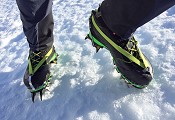

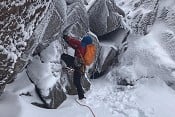
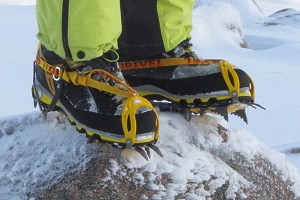
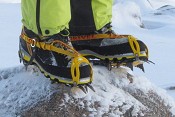
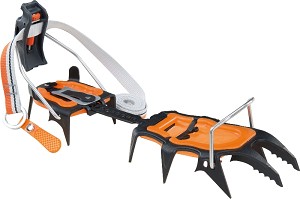
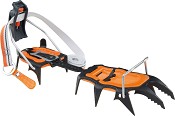



Comments
Your comment about the short spikes underfoot being good for things like Striding Edge and Crib Goch struck a chord with me - I last did winter traverses of Crib Goch a year ago, and Striding Edge a month ago. For years of winter climbing in England and Wales I've favoured a pair of CT Nuptse 12 point and BD Snaggletooth 11 point crampons BECAUSE of their relatively short downward pointing points, because with marginal winter conditions becoming ever more common, you are less often cramponing in deeper snow conditions and I've found more often on ice and snow glazed rock and going through the snow to gravel, grass or slab underneath. Shorter downward points are definitely much more stable and less prone to causing trips that crampons with longer points. I'm sure I'd miss the frontpoints though as from habit I do sometime kick in to snow, even if it would be perfectly possible to flat foot it all.
I love this middle ground area grey area. A few years ago a friend and I both wore Grivel micro spikes out over Aonach Mor. We found something interesting in terms of their limitations. Whereas I'd worn them with some fancy pants carbon soled Salomon X Alps (or whatever they were called?) and my friend wore La Sportiva trail running shoes; I was fine on ice, but she struggled. The hard ice effectively forcing the spikes upwards into her soft soled shoe and not getting any purchase, whereas my firm soles forced the spikes to dig into the ice. Conversely, firm soles fared less well on soft snow, compared to the trail shoes.
Just an FYI for the KTS you can buy Snow release Skins, a handy addition.
https://kahtoola.com/accessories/kts-snow-release-skins-srs/
Thanks, that's good to know - though I've not found them too bally at all!
Ye I just noticed a one line in your review mentioning it, and everybody loves accessories!!!